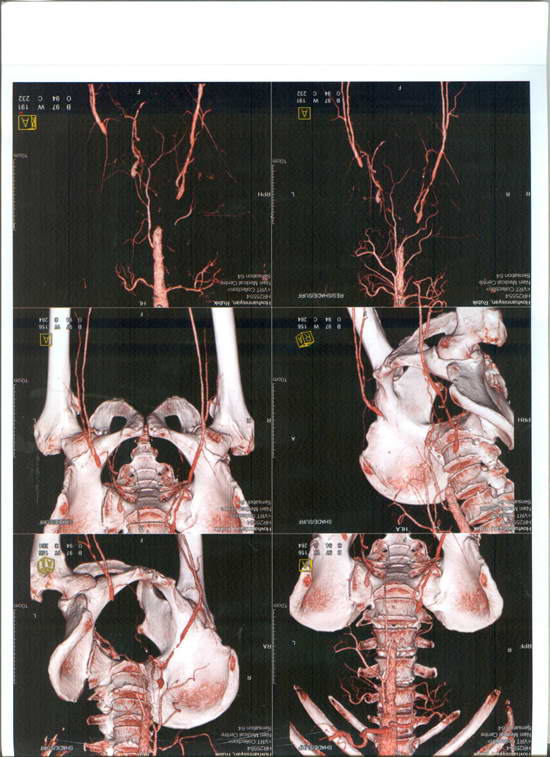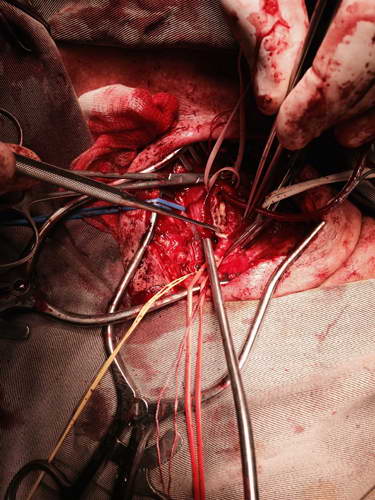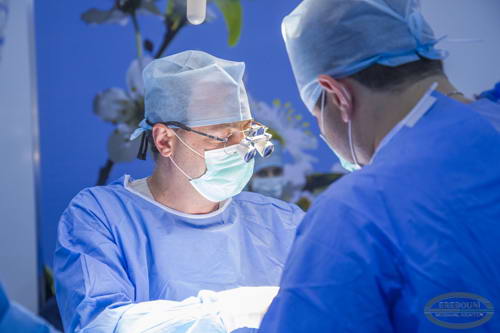The most common disease that leads to arteries blockage the atherosclerosis is characterized by the so-called multifocal lesions. This means, that atherosclerosis affects several arteries of the body. The most common are different combinations of lesions of coronary arteries, carotid arteries and arteries of the lower limbs.
Currently there are a few methods of the effective treatment of narrowing/blockage of the arteries - grafting, bypass surgery, endarterectomy, balloon dilatation and stenting. The choice of treatment (with other things being equal) depends on the presence of concomitant diseases and the extent of their manifestation.
Recently in MC Erebouni took place a case; it was carried out simultaneous surgery for the treatment of stenotic carotid artery and the aortic occlusion.

The patient R.A., 61-years-old, has a myocardial infarction, which is a consequence of the lesion of coronary vessels of the heart. In addition, he has atrial fibrillation. The patient was under the supervision of cardiologist and was getting warfarin (recently it was taken irregularly). More than 10 years ago he was diagnosed diabetes, for the treatment of which he took pills, and more recently – insulin. At the same time he continued smoking 20 cigarettes per day. During the last year he complained for lameness, pains in the right lower leg after 150-200 meters of walking, but he didn`t have any examination/tests and wasn`t treated. A few months ago a prostate tumor was discovered, the malignant nature of which was established during the examination. The patient was admitted to hospital because of pneumonia, but during the treatment suddenly started pain in the right lower limb, cooling, numbness, walking became impossible.
The patient was diagnosed: blockage of the arteries in the left lower limb, the vascular surgeon was invited and in 19.08.2015 the patient was transferred to MC Erebouni.
The additional examination methods of the patient has shown;
- Blockage of the final part of the abdominal aorta and both iliac arteries. In this case, the right iliac artery occlusion occurred earlier, and was the cause of intermittent lameness, but blockage of the aorta and the left iliac artery occurred in 3 days – on the background of already existing narrowing. Blood circulation of the left limb has deteriorated sharply, there is a real threat to the development of gangrene (SCANCT)
- It has been found the stenosis of both internal carotid arteries about 75% (the stenosis is almost equal, but on the left carotid artery was parietal thrombus)
Additionaly it was revealed;
- coronary heart disease, myocardial infarction, persistent artrial fibrillation,
congestive heart failure NYHAII-III, diabetes II degree (insulin dependent), decompensation stage,
- Prostate cancer with metastatic lesions
- Chronic bronchitis, bilateral pneumonia
The main complaint of the patient was the state of the left lower limb. However, the presence of bilateral stenosis of the carotid arteries requires prior intervention on this pool. Only after that, the second stage of the surgery on aorta is could be possible, and preference is given to open surgery of aorto-femoral bifurcation bypass, i.e. imposition of prosthesis from aorta to both femoral arteries. At the same time the presence of many pathological lesions makes too risky the huge open surgery volume. Consequently, the only possibility to provide the inflow of arterial blood in the lower limbs and to avoid gangrene remains the imposition of the prosthesis from the subclavian/axillary artery to femoral - axillo-femoral bypass.
Thus, it was decided to carry out a left –hand carotid endarterectomy both lef-handed axillo-femoral bypass.
Therefore, taking into account the need for primary intervention on the carotid arteries, severe disturbance of the left lower limb blood flow and other diseases, it was decided to carry out simultaneously left carotid artery endarerectomy and left femoral bypass.
After appropriate preparations, in 20.08.2015 under general anesthesia, by the Head of Vascular and Laser Surgery Department Dr. A.C. Badalyan was carried out the surgery, which lasted for about 3.5-4 hours and was uneventful. The blood circulation in the lower limb has improved significantly, the pain have significantly subsided, the patient is able to walk to 200 m without pain in the left leg. The patient was discharged in 29.08.2015.


It is planned to carry out surgery at the right internal carotid artery after the completion of the first phase of oncological treatment.
It should be noted, that interventions on the carotid arteries, lower limbs or aorta us separate intervention in our clinic are carried out very often, in the everyday work. However, simultaneously performed interventions, which are implemented in the presence of other severe diseases, are unique in its kind.



